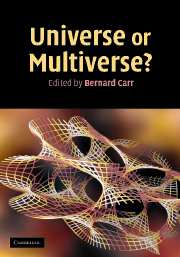Book contents
- Frontmatter
- Contents
- List of contributors
- Preface
- Acknowledgements
- Editorial note
- Part I Overviews
- Part II Cosmology and astrophysics
- 4 Cosmology and the multiverse
- 5 The anthropic principle revisited
- 6 Cosmology from the top down
- 7 The multiverse hierarchy
- 8 The inflationary multiverse
- 9 A model of anthropic reasoning: the dark to ordinary matter ratio
- 10 Anthropic predictions: the case of the cosmological constant
- 11 The definition and classification of universes
- 12 M/string theory and anthropic reasoning
- 13 The anthropic principle, dark energy and the LHC
- Part III Particle physics and quantum theory
- Part IV More general philosophical issues
- Index
- References
12 - M/string theory and anthropic reasoning
Published online by Cambridge University Press: 05 July 2014
- Frontmatter
- Contents
- List of contributors
- Preface
- Acknowledgements
- Editorial note
- Part I Overviews
- Part II Cosmology and astrophysics
- 4 Cosmology and the multiverse
- 5 The anthropic principle revisited
- 6 Cosmology from the top down
- 7 The multiverse hierarchy
- 8 The inflationary multiverse
- 9 A model of anthropic reasoning: the dark to ordinary matter ratio
- 10 Anthropic predictions: the case of the cosmological constant
- 11 The definition and classification of universes
- 12 M/string theory and anthropic reasoning
- 13 The anthropic principle, dark energy and the LHC
- Part III Particle physics and quantum theory
- Part IV More general philosophical issues
- Index
- References
Summary
Introduction
After the development of inflationary cosmology, anthropic reasoning (AR) became one of the most important methods in theoretical cosmology. However, until recently it was not in the toolbox of many high-energy physicists studying 11- or 10-dimensional M/string theory and supergravity. The attitude of high-energy physicists changed dramatically in 1998, when the physics community was shocked by the new cosmological observations suggesting that we may live in a world with a tiny cosmological constant, Λ ~ 10–120M4P, with a weird combination of matter and dark energy.
The recent WMAP observations seem to confirm the earlier data and also support the existence of an inflationary stage in the very early Universe. In view of the accumulating observational evidence, the level of tolerance towards AR is currently increasing. More people are starting to take it into consideration when thinking about cosmology from the perspective of M/string theory and particle physics. I belong to this group, and I recently had two rather impressive encounters with AR that I would like to discuss in this chapter.
In the first encounter, Andrei Linde and I considered a model of maximal supergravity related to the 11-dimensional M-theory, which has a 4-dimensional de Sitter (dS) solution with spontaneously broken super-symmetry [1]. We found that this model offers an interesting playground for the successful application of AR.
- Type
- Chapter
- Information
- Universe or Multiverse? , pp. 191 - 210Publisher: Cambridge University PressPrint publication year: 2007
References
- 1
- Cited by



